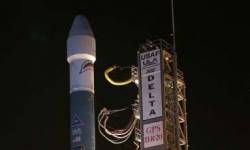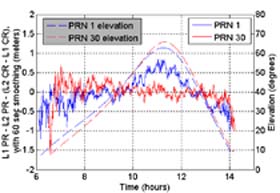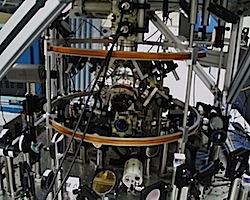
When GPS reference receivers at the European Space Operations Center (ESOC) detected a 150-meter error in the broadcast ephemerides (orbital position) for the latest GPS satellite — Space Vehicle Number 49 or SVN49 — scientists there assumed that a problem had arisen with the spacecraft’s navigation payload.
After all, coupled with an apparent 500-nanosecond clock error, the ephemerides could produce many kilometers of errors for navigation receivers.
When GPS reference receivers at the European Space Operations Center (ESOC) detected a 150-meter error in the broadcast ephemerides (orbital position) for the latest GPS satellite — Space Vehicle Number 49 or SVN49 — scientists there assumed that a problem had arisen with the spacecraft’s navigation payload.
After all, coupled with an apparent 500-nanosecond clock error, the ephemerides could produce many kilometers of errors for navigation receivers.
Turns out, however, that the presumed “bug” was in fact a feature of the U.S. Air Force efforts to correct the signal anomaly first detected April 10 on SVN49. That anomaly produced elevation-dependent pseudorange errors, particularly for transmissions at the L1 frequency, according to the GPS Wing — that is, the pseudorange errors changed with the angle of elevation of the satellite as it passed through the sky.
An article in the forthcoming (July/August) issue of Inside GNSS (and available now on our website) describes the nature of the anomaly and the effects of the proposed solution. Two articles in the current (May/June) issue of Inside GNSS also describe the pseudorange anomaly.
According to industry sources, and the GPS Wing, a decision to run power to the L5 transmitter through an existing 50-ohm port rather than build in new circuitry created an instability in the resulting antenna phase and group delay centers.
The tweaking of the satellite broadcast ephemerides and time is designed to reduce the pseudorange error to within the specifications for GPS Standard Positioning Service and Precise Positioning Service.
Lockheed Martin modified the SV, a modernized Block II replenishment series satellite designated IIR-20(M), to accommodate the L5 demonstration payload in order to meet an International Telecommunications Union deadline for establishing GPS primacy in the band. ITT Corporation built the navigation payload for the spacecraft as it has for all GPS satellites.
If no major issues are observed during a planned test campaign to evaluate the fix, the GPS Wing says it expects that SVN49 will join the GPS constellation in October.





